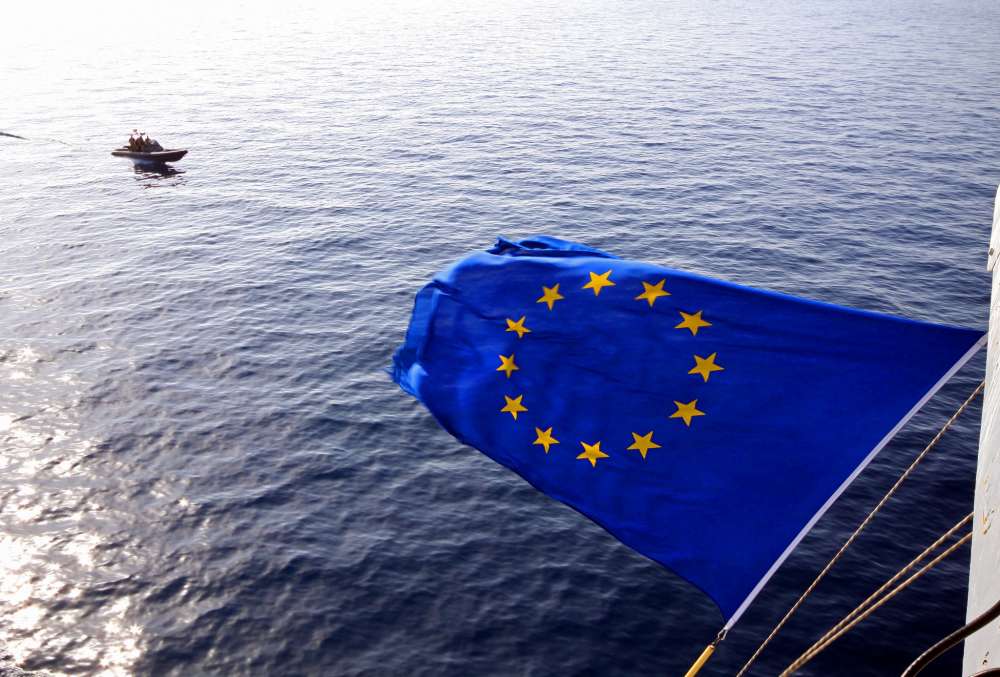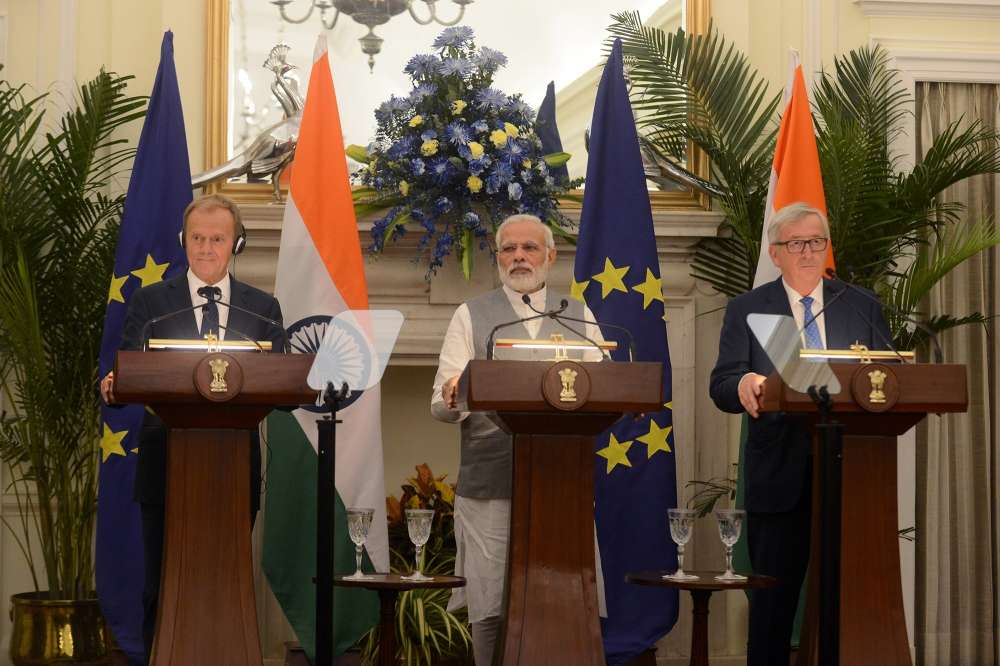Politics Over Trade: A Revival of the EU-India Partnership

The EU-India relationship is witnessing an extraordinary momentum, which was lost after the promising beginning of the strategic partnership the early 2000s. For a long time, New Delhi saw Brussels only as a trade bloc, preferring bilateral partnerships with Member States for all political and security matters. The EU on the other hand focused largely on China in its Asia policy. However the past few years have marked a turning point. Both actors are taking unprecedented steps to deepen their strategic partnership. The annual EU-India Summits are back on track, restarting in 2016 after a four year gap. The EU is also in the process of revising its strategy for India, the earlier version of which was produced in 2004. The partnership has refocused on political, security and strategic issues, broadening from trade and culture which had long been the defining characteristic of EU-India relations.
With an assertive China and uncertainty of US policy under Trump, Europe and India have realized they have much to offer each other. China’s increasing presence in Europe and South Asia is creating similar political, economic and even security concerns for EU and India. Motivated by the need to diversify its partnerships and balance Beijing, India is seeking to partner with other middle powers like Japan, Australia, but also the EU and Member States like Germany and France. Indian foreign policy’s ‘multi-alignment’ approach and souring of relationship with Russia – which is privileging its partnership with China over India – is also creating more space in Delhi to explore ties with the EU. Brexit is another crucial factor, pushing India to look for new ‘gateways’ to Europe, as its traditional partner leaves the Union. For the EU, the need to strengthening multiple partnerships in a resurgent Asia is clear.
This article will explore the new ways in which Europe and India are developing a closer partnership – particularly through political and security cooperation. It will also cover the FTA which has become a major roadblock in an otherwise buoyant EU-India partnership and discuss ways to circumvent it.
Strengthening the Political & Security Partnership
The clearest sign of the EU-India partnership changing track is their deepening cooperation on political and security issues, which is beginning to make the partnership truly ‘strategic’. The 2016 EU-India Summit’s ‘Agenda for Action 2020’ document reflects this change clearly. As a result, the EU and India have recently instituted several mechanisms for greater cooperation on pressing security challenges like counter-terrorism, maritime security, and nuclear non-proliferation.
Maritime security particularly in the Indian Ocean is a promising area for Europe and India to extend their cooperation in their overlapping, extended neighborhoods. Initially EU-India cooperation in this region was limited to anti-piracy operations, with little success in getting India on board with EU’s ATALANTA mission. India saw the EU as having a limited role in the region, both geographically (in the Western Indian Ocean and Europe’s near seas) and policy-wise (limited to non-traditional security issues).
This has now significantly shifted. The Indian Ocean is fast emerging an arena for geopolitical and geo-economic competition with China’s entry in the region. Increasing PLA-Navy presence has spurred a ‘naval base race’ and security competition among middle powers in the region. China’s Belt and Road Initiative’s (BRI) massive economic investments along the Indian Ocean have raised concerns around debt traps, increasing Chinese political influence in domestic politics, and regional stability. As competition increases, both Europe and India will be directly impacted by these developments. Not least because the Indian Ocean is the main conduit for global trade and energy flows which, if disrupted, will have substantial ramifications for Europe and India. More than 35% of all European exports, and around 20% of all German exports go to Asian markets with a majority (approx. 90%) transiting through the Indian Ocean. Similarly 80% of India’s oil requirements and 95% of its trade passes through the Indian Ocean. Given these stakes, India now sees the EU as an important partner in securing the Indian Ocean by strengthening institutions, rule of law, and a regional security architecture than can check competition and militarization in the region.
A second promising area of cooperation is connectivity – trade, infrastructure, energy, digital, and people to people links connecting Europe and Asia. China is currently the key actor aiming to build ports, road and rail networks connecting the two continents. The convergence of Europe and India’s position on BRI, as well as the underlying norms and rules for connectivity projects as such, is also a new and interesting opportunity. While Europe is keener on participating in BRI than India, both actors agree than investments in BRI should be transparent, sustainable, follow international norms and standards and should not have overlapping commercial and military uses. Europe’s encounter with BRI mirrors South Asia’s experience – particularly bad lending practices potential endangering financial stability of smaller countries (example Montenegro, Hungary), dual use of civilian projects for military purposes, and attempts to undermine EU unity through political interference. All of these trends are visible from Pakistan to Sri Lanka. Many Indian policy makers, as a result, are keenly observing Europe’s response to BRI. Brussel’s upcoming Communication on Euro-Asia Connectivity will outline how the EU seeks to work with partners in improving connectivity between Europe and Asia. This can be a stepping stone for expanding its partnership with India.
While small steps, these developments signal new potential for the EU-India partnership. Particularly as the two partners are now seeking coordination on just bilateral but also regional issues. It will still be a while however, before India takes the EU seriously as a political and security partner. There is a tendency among India and other Asian partners to view the EU as a “payer not player”. The new council conclusions on increasing EU’s security engagement with and in Asia are a step towards changing this perception. If implemented, the EU will be able to increase its visibility in the region by building on Member States’ already substantial engagement. This will certainly add a new dimension to its partnership with India.
Trade Woes
While there is movement in many aspects of the strategic partnership, an issue that remains stuck for now is the EU-India Free Trade Agreement (FTA), officially known as the Bilateral Trade and Investment Agreement (BTIA). The negotiations remain caught even after approximately 16 rounds of talks conducted till date. In the past, negotiations were stalled due to larger political events, for example the detention of Italian marines in India which derailed the whole partnership significantly. The current sticking points are intellectual property rights, duties on automobiles and spirits, and visa regimes in Europe. The EU is demanding duty cuts on automobiles, wines, spirits and dairy products it exports to India, along with a strong intellectual property regime. India is asking for better mobility of its service professionals within Europe under a more liberal visa regime, and for data secure nation status – crucial for Indian IT companies wanting market access in Europe.
Some experts argue that Brexit might make the EU-India BTIA negotiations easier, as the UK was one of the main opponents of liberalizing the visa regime. Both France and Germany have been pushing for resumption of BTIA negotiations too as, with the UK gone, both countries stand to gain more from a free trade agreement with India. However the visa regime is an issue for a number of other member states as well, and given the domestic political climate in many EU countries around issues of migration, movement of service professionals will remain a tricky issue politically. India too has long been skeptical of free trade agreements and negotiators are overly cautious after mixed experiences with its ASEAN deal.
The path ahead for BTIA negotiations remains perilous. With national elections around the corner in India, the political push required for starting yet another round of negotiations is missing. Many on the Indian side feel the negotiations have dragged on for too long and it might be a safer bet to switch to a less comprehensive agreement. This would mean either reducing the issues which require negotiation or embedding the trade negotiations within a broader political process. Some experts suggest a high level strategic and economic dialogue which would provide a platform for discussing trickier issues while not holding up progress on other areas. In other words, an ongoing dialogue instead of an all or nothing agreement. Such a dialogue would go beyond the trade negotiators and might benefit from the overall political momentum.
Sustaining the Momentum
The problems in BTIA negotiations are somewhat symbolic of problems in the larger EU-India partnership. Quite often Member States have the tendency to push tougher issues, like those concerning human rights violation, to the EU level. India on the other hand has limited capacity to deal with the myriad EU institutions and negotiations. India’s former foreign secretary Shyam Saran captures India’s view of Europe, when he writes in his book How India Sees the World that internal crisis, Brexit, and US-Europe tensions have impacted “the promise of a cohesive Europe playing the role of an influential actor”. India’s own focus on tackling with China’s increasing influence in South Asia, developing new partnerships, trilaterals and ‘minilaterals’ in Asia leaves very little bandwidth for engagement with Europe. This will be an uphill task as both Europe and India remain distracted by their domestic politics and their respective neighborhoods.
In order to sustain the present momentum in EU-India ties, both actors will have to make an extra effort to convert converging interests into concrete cooperation. The dynamics in the Indian Ocean and increasing presence of China in Eurasia could be crucial policy issues to drive the EU-India partnership forward. The EU should seriously think of what shape its engagement in the Indian Ocean will take particularly after the ATALANTA mission. On connectivity too, the EU should consider actively reaching out to partners like India and Japan, in addition to improving connectivity within Europe. Both India and Europe should devote their relatively scarce resources to promising areas within the political and security partnership outlined above, rather than the obstinate FTA negotiations.
There is cause for optimism. The political will from both sides to improve ties is reminiscent of the early, heady years of the EU-India partnership. Through several dialogue formats, Brussels and New Delhi are making an effort to understand each other’s positions and constraints better. Indian foreign policy’s multi-alignment approach has made room for reviving several partnerships while tensions in the Trans-Atlantic partnerships has pushed Europe to carve out its own Asia policy. EU-India observers had long lamented that the partnership was all about trade and not ‘strategic’ enough. Those trends are finally shifting.
…
A German version of this article was originally published September/October issue of Internationale Politik.







